How does yoga help with digestion?
8In my therapist training many years ago my teacher had asked for a volunteer with some sort of digestive distress when we were discussing the topic of digestion. One of the teachers volunteered, admitting that she had suffered from chronic constipation (yes, the environment in the yoga therapist training program is so supportive that people feel comfortable sharing all sorts of issues 🙂 ). My teacher led her through a slow deliberate practice that was meant to move things along. The next day that teacher-volunteer reported that she had had three bowel movements since that practice. I’ve never seen a room full of people cheer a mention of bowel movement before.
It is often said that twists facilitate digestion. And it’s fairly easy to experience it yourself – you are likely to feel very hungry following a twist-focused practice. So how do twists affect our digestive system? What kind of practice is more appropriate to “get things moving” and when should we do that practice? Let’s take a look.
To get a better idea of what’s going on, let’s break the digestive cycle down into 3 main parts based on the organ that does the work and see when and why a yoga practice is appropriate.
Stage 1 – Stomach (digestion)
Stage 2 – Small intestine (nutrient absorption)
Stage 3 – Colon (water absorption, elimination).
1. Stomach
Once the food arrives in the stomach, the initial contractions begin. First they are very weak, but within an hour they increase in intensity and soon the material in the stomach is churning like clothing in the washing machine. Robert Sapolsky, a professor of biology and neurology at Stanford University says: “Your stomach not only breaks down food chemically, it does so mechanically as well. It undergoes systolic contractions: the muscle walls contract violently on one side of your stomach, and hunks of food are flung against the far wall, breaking them down in a cauldron of acids and enzymes.”(1) That goes on for couple of hours or more, depending on the quantity and composition of food ingested.
It is important to understand that “the secretion of digestive enzymes anywhere in the upper GI tract is largely a function of the vagus nerve, the biggest contributor to the parasympathetic nervous system. In this way the efficiency of digestion depends on whether a person is in a sympathetic or parasympathetic state.”(2) This is a crucial point. At this stage the best thing we can do for our digestion is calm down. If we fall into the sympathetic mode (“fight-or-flight”) the blood will get pulled away from the stomach and into the large skeletal muscles, so that you could fight or run away. Robert Sapolsky: “Digestion is quickly shut down during stress. Your stomach grinds to a halt, contractions stop, enzymes and digestive acids are no longer secreted.”(1) The interesting thing is that you will get a similar reaction if you begin exercising vigorously shortly after dinner. Studies show that “exercise is characterized by a shift in blood flow away from the gastrointestinal (GI) tract towards the active muscle and the lungs. Changes in nervous activity, in circulating hormones, peptides and metabolic end products lead to changes in GI motility, blood flow, absorption and secretion.” So vigorous exercise would compete with the digestive process, slowing it down.
Another thing to remember is that digestion takes a lot of energy (10-20% of our overall daily energy). Mel Robin, MD says: “Following a meal, the gut demands considerable oxygen, glucose and ATP in order to drive acid production. Because these materials are also in demand when doing the physical work of the yogasana, it is not a good idea to try to perform yogasana and digestion simultaneously.”(3) This is why it is better to have a lighter meal and then wait at least an hour or two afterwards before beginning a yoga practice. So at this stage any sort of twisting or forward bending is not advisable.
One thing that is beneficial after a meal is a brisk walk. Research confirms that a post-meal walk, as short as 15 minutes, can in fact help with digestion and improve blood sugar levels.
2. Small intestine
The stomach turns food into chyme, and small quantities of chyme begin to arrive in the small intestine. Those quantities need to be small “to ensure that the secretory, digestive, and absorptive functions of the small intestine can begin with reasonable efficiency”(4). Robert Sapolsky: “The small intestines do a snake dance of peristalsis (directional contraction), contracting the muscular walls at the top end in order to squeeze the food downstream in time for the next stretch of muscle to contract. […] Circular muscles called sphincters located at the beginning and end of each organ open and close, serving as locks to make sure that things don’t move to the next level in the system until the previous stage of digestion is complete, a process no less complicated than shuttling ships through the locks of the Panama Canal. “
This last statement is really important. Until the body is done processing the food in one stretch of your intestines, it will not be moved to the other. Therefore we cannot rush the process along by twisting – this isn’t like trying to squeeze the contents of a sausage out of it’s casing. But what we can do is increase the blood flow to the area by gentle abdominal contraction. William Blahd, MD says: “Since the strength of the gut’s muscle contractions directly relate to the quantity of blood flowing in the area, less blood in the GI tract means weaker intestinal contractions, fewer digestive enzymes, and the food waste moving sluggishly through the intestine.” One assumes that the opposite is also true – that the increased blood flow to the small (and large) intestine means stronger intestinal contractions, more digestive enzymes, and chyme moving along with a bit more vigor.
Twists and forward bends do just that – they gently compress the abdominal contents, increasing the blood flow to the area. Another important point here is that both twists and forward bends are done with prolonged exhalation, which facilities the parasympathetic activation (rest-and-digest mode). “The stimulation of the parasympathetic system increases the sensitivity of the weak myenteric reflexes [reflexes that lead to contraction of the digestive tube above and relaxation below the place where it is stimulated by an accumulated mass of food] within and accelerates both peristalsis and segmentation.”(4)
We have to be careful not to over do it with the abdominal compression though – if we apply continuous pressure on the abdomen, it will make the digestion sluggish, as it shows in this article that investigates the effect of wearing a corset on different organs. So along with twists and forward bends we need to make sure to include other movements that would stretch and expand the abdomen.
3. Colon
Once the small intestine has extracted about 90% of nutrients out of food, the chyme enters colon, where the rest of the nutrients will be absorbed along with 99% of water. This is a long process that will take 10 hours or more. As the water is absorbed, the moving mass becomes more and more dense and presses firmly against the walls of the colon. This pressure on the intestinal walls stimulates the peristalsis that carries it toward the anus for easy expulsion.
If the food was low in fiber, the resulting stool will be greasy and small, which prevents it from pressing on the abdominal walls, which in turn fails to elicit a strong peristaltic reflex. This makes it harder to move the stool though and get it out. Mel Robin, MD: “Many years of a low-fiber diet will result in a colon that is weak and flabby from lack of exercise.” Yes, we need to exercise our colons, too!
Can we exercise the colon and help move the stool along with twisting? According to Mel Robin, we cannot: “Note that any pressurization of the wall from the outside toward the inside as with the wringing action of Maricyasana 3, for example, does not activate the stretch receptors in the intestinal wall, so it will not promote peristalsis.”(3) On the other hand, it seems possible that the external pressure from the abdominal compression might increase internal pressure (of the stool on the abdominal walls), which, in turn, can facilitate the peristaltic reflex. Maybe that’s why the most effective practice for constipation in viniyoga therapy is twisting and bending forward on hold after the exhalation. That way we create a slight abdominal compression via the abdominal contraction on the exhalation and then intensify that compression by twisting or bending forward. It also seems to work better if we move in and out of the pose, rather then holding the pose. This is the kind of practice that helped the teacher-volunteer from the beginning of this post.
I couldn’t find any evidence that supports the popular idea that we should twist on the right side first and then the left (or visa versa) to facilitate the movement of waste along the colon. First of all, no matter what side we twist on first, the movement of stool along the colon will not be reversed, nor will it slow down. Second, it is doubtful that we can have great precision as far as which side of the colon gets compressed, especially if you twist with progressive abdominal contraction (as you should). If somebody knows of other resources that support this theory I would love to hear about it.
To sum it up: it is clear that the parasympathetic nervous system mediates the actions of digestion. Gentle twists and forward bends (especially done with prolonged exhalation) facilitate the relaxation response. The increased blood flow to the intestines seems to increase their motility (movement within the organ) and it is possible that the external abdominal compression affects the internal pressure which can result in improved peristalsis. We have to remember though that when it comes to digestion, it is not the speed of peristalsis that matters, but how rhythmic, smooth and coordinated it is. If it becomes uncoordinated and irregular, all kinds of digestive problems can show up.
So far we have talked about Western approach to digestion, but both yoga and Ayurveda have their own developed systems that interpret the process of digestion and offer tools to troubleshoot it. We will talk about that in a couple of weeks.
Quoted Resources
1. Robert Sapolsky Why zebras don’t get ulcers
2. Ruth Werner A massage therapist’s guide to pathology
3. Mel Robin A physiological handbook for teachers of Yogasana
4. Frederic H. Martini Fundamentals of anatomy and physiology
[jetpack_subscription_form]

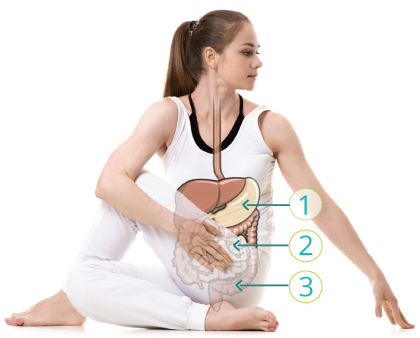

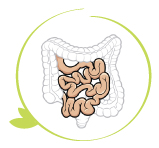
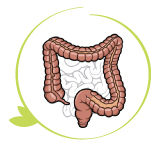
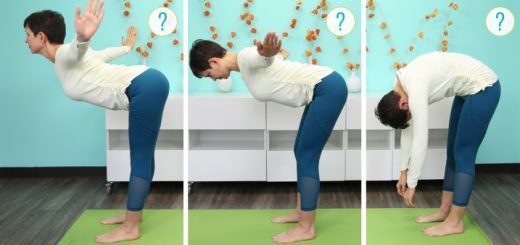
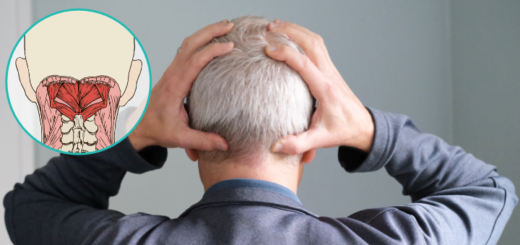
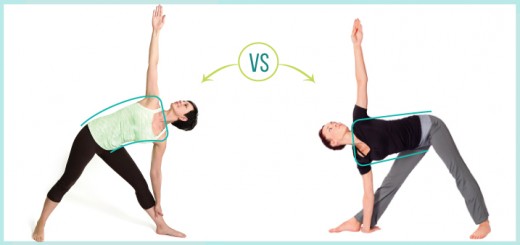
















Can you share techniques (other than the viniyoga you mention)? Would be grateful!!
Hi Patti! The techniques depend greatly on the condition: constipation, diarrhea, irritable bowel, etc. I suggest you check out Yoga for Wellness by Gary Kraftsow; he has some great points on how to approach each one and couple of sequences.
I 2nd Olga’s recommendation of Gary Kratfsow’s book Yoga for Wellness.
Very useful
love your articicles! tks!
Hari Om Olgaji
Wonderful insights! Thanks a lot!
In fact an efficient digestion-assimilation- elimination process is an acid test for sound health.
Would you be sharing a sequence for this?
Yogicly
Abhinandan
Hi Abhinandan! I wasn’t planning on it – there are so many variables that need to be considered. I would recommend Yoga for Wellness by Gary Kraftsow, it has many excellent therapeutic case studies and practices. I don’t know if you have access to the book, so some time soon I might add a digestive sequence to Shared sequences on Sequence Wiz. Stay tuned!
This is an interesting article and sheds some light on physiological mechanisms through which yoga works. In my experience, yoga can be very effective against constipation, and gentle vinyasa class was as useful as a class focusing on breath and relaxation. I think kapalabhati and uddiyana bandha were particularly powerful techniques. Interestingly, while led classes worked for me, following very similar sequences on my own at home was completely useless. This was true for the suggested sequences from Yoga for Wellness as well – doing them on my own was really pointless. I do not doubt that under the guidance of a good teacher these sequences would work. Unfortunately, at this stage of my practice doing sequences on my own is of very limited value. Any similar experiences or ideas why this might be the case?